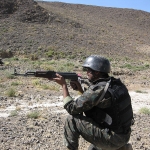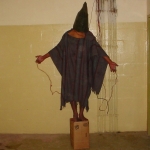IRAQ: Iraq war logs: WikiLeaks' virtual memorial
A short, sharp burst of gunfire into their speeding vehicle killed three Iraqi police officers immediately, and wounded another. On the fifth anniversary of the US invasion of their country, the Iraqi police were on their way to help the 87th infantry regiment of the US Army just outside the volatile city of Kirkuk to defuse a possible car bomb. A trigger-happy US gunner, mistaking them for possible insurgents, brought a sudden and tragic end to the police mission.
The detailed incident report (# 342:001) recorded by the US military is now available thanks to Wikileaks - three deaths from a list of 44 people killed on 19 March 2008. It confirms a much shorter incident report in the meticulous records kept by Iraq Body Count, a volunteer group of ordinary citizens who have made it their mission to track the number of people killed in Iraq since 19 March 2003. Each such incident logged in their database has been confirmed by at least two different sources.
"However many civilians are killed in the onslaught on Iraq, their death toll should not go unnoticed by those who are paying, in taxes, for their slaughter," read the original mission statement of Iraq Body Count. In the middle of their homepage, the group has highlighted the now famous comment of General Tommy Franks made early on in the global "war on terror": "We don't do body counts."
Now, Wikileaks has made it possible for Iraq Body Count to prove that the Pentagon has, indeed, secretly always known the names and details of how many died.
Both the military and the volunteer databases capture roughly 108,000 deaths since the invasion. But a close comparison of the two made by several Iraq Body Count volunteers working in secret around the clock over the last few weeks has determined that only about 64,000 civilian deaths match, suggesting that if the two databases were merged - the real toll of documented violent deaths (civilian and combatant) is actually 150,000. (The Pentagon lists another 192,695 injured.)
For example, Iraq Body Count has documented 17 border guards shot to death on 19 March 2008 in Basra. The Iraq war logs, kept by the Pentagon, logged no such incident. On the other hand, the Pentagon database caught a death on the same day that Iraq Body Count did not list: the killing of Hibah Ahmad Kazim Aboud (# 072:444) in Najaf, a 13-year-old girl, who had been "shot in the head with AK-47 rifle rounds".
There are some 93,553 pages of such deadly incidents and they range from the criminal to the tragic: The first civilian death recorded on 1 January 2004 (# 070:114) is that of Abdul Jubar Mustafa, the dean of science in al-Hamdaniya, near Mosul, who was killed by a gunshot to the head by unknown assailants.
The last recorded civilian death, on 31 December 2009 (# 016:766), is that of an unnamed, and apparently drunk, Iraqi who was driving south near the city of Babylon in a Toyota Landcruiser when he came upon a US armoured vehicle from the 180th Transportation Battalion driving the wrong way in his lane. He swerved, lost control of his car and died, when his car hit a heavy equipment transporter vehicle.
Between those two dates, I remember a short visit that I made to the Baghdad morgue in April 2004, on my second visit to the country. I walked through the quiet hallways, whose pink walls were suffused with a meditative glow by the sunlight streaming in from the skylight. I met with Dr Kais Hassan Salman, the director of statistics, to ask him if it was true that violence was on the rise. He frowned and pulled a sheaf of papers from his desk and dutifully reeled off the numbers: "January 2003, 10 bodies; February, 1; January 2004, 500; February, 394." Dr Abdul Razzak al-Obaidi, the deputy director of the Baghdad morgue, told me that many of the bodies were never identified nor claimed.
The figures were staggeringly different - roughly 25 times higher than before the invasion. I didn't know it at the time, but the figures would rise much, much higher over the course of the next five years to 100 or more every single day at the height of the sectarian frenzy in 2005 and 2006. And hundreds more would perish in the US-led bombings of Fallujah and other cities.
Over the years, those body counts became actual names to me. I remember Ghareeb, who drove an ambulance through the gunfire to rescue people in Fallujah, only to be shot in the head outside Najaf by militants. I remember a friend-- Marla Ruzicka - who died in a suicide bomb attack in Baghdad after devoting her life to create Campaign for Innocent Victims in Conflict - to make amends to those who died in the Afghanistan and Iraq. I remember having to break the news of how Sascha Grenner-Case, a Halliburton trucker, was killed to his grieving partner in Sierra Vista, Arizona, because the Pentagon would not call her back. This list goes on.
Seven years after the fall of Saigon in 1975, construction began on a memorial in Washington, DC. Today, there are 58,267 names listed on the Vietnam memorial, to honour the US soldiers who died in that pointless war. Now, seven years after the invasion of Baghdad, Wikileaks has created a virtual memorial to the many who perished in another pointless war. I searched that virtual wall in the last few days to find more names of my friends who died, half-afraid that of what I would discover.
And I wonder: shouldn't the Pentagon have told us what they knew all along, instead of pretending that they didn't know and claiming that everything was going well? If, every day, they had had to tell the public what so many of us experienced of the true human cost of war, perhaps the violence would have ended sooner.



